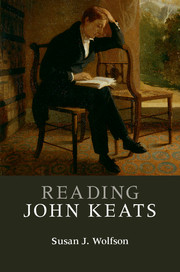Book contents
- Frontmatter
- Dedication
- Contents
- List of figures
- Preface
- Acknowledgments
- Note on the texts
- List of abbreviations
- 1 Life and times
- 2 Conceiving early poems, and Poems
- 3 Falling in and out of love with Endymion: A Poetic Romance; rereading King Lear
- 4 Venturing “new Romance”: Isabella; or, The Pot of Basil. A STORY FROM BOCCACCIO
- 5 Falling with Hyperion
- 6 Still Romancing: The Eve of St. Agnes; a dream-sonnet; Labelle dame
- 7 Reforming the sonnet and forming the Odes of spring 1819: Psyche; Nightingale; Grecian Urn; Melancholy; Indolence
- 8 Writhing, wreathing, writing Lamia
- 9 Falling in Fall 1819: The Fall of Hyperion and To Autumn
- 10 Late poems & lasting Keats
- A few famous formulations
- At a glance: Keats in context
- Notes
- Further reading
- Index
8 - Writhing, wreathing, writing Lamia
Published online by Cambridge University Press: 05 June 2015
- Frontmatter
- Dedication
- Contents
- List of figures
- Preface
- Acknowledgments
- Note on the texts
- List of abbreviations
- 1 Life and times
- 2 Conceiving early poems, and Poems
- 3 Falling in and out of love with Endymion: A Poetic Romance; rereading King Lear
- 4 Venturing “new Romance”: Isabella; or, The Pot of Basil. A STORY FROM BOCCACCIO
- 5 Falling with Hyperion
- 6 Still Romancing: The Eve of St. Agnes; a dream-sonnet; Labelle dame
- 7 Reforming the sonnet and forming the Odes of spring 1819: Psyche; Nightingale; Grecian Urn; Melancholy; Indolence
- 8 Writhing, wreathing, writing Lamia
- 9 Falling in Fall 1819: The Fall of Hyperion and To Autumn
- 10 Late poems & lasting Keats
- A few famous formulations
- At a glance: Keats in context
- Notes
- Further reading
- Index
Summary
Critical Judgment
The reason he had the truant Knight at arms give La belle dame “kisses four,” Keats jests, was a “wish to restrain the headlong impetuosity of my Muse—she would have fain said ‘score’ without hurting the rhyme – but we must temper the Imagination as the Critics say with Judgment” (K 249). If a venture “without Judgment” was the regret of Endymion (October 1818; K 207), Keats had “great hopes” for Lamia, “because I make use of my Judgment more deliberately than I yet have done” (11 July; L 2:128). While Isabella and The Eve of St. Agnes might be “laugh'd at,” he was confident of “no objection of this kind to Lamia” (L 2:174).
Lamia is saturated with corrosives to “golden-tongued Romance,” that Syren bid a too-lingering farewell in the sonnet of January 1818. Keats sets the main scene in urbane Corinth, famed for its “temples lewd” (1.352, hubs of prostitution), its material luxury, and (this is ancient Greece, after all) its school of Platonic philosophy. The characters are insidious caricatures of Keatsian antecedents. Young Lycius is a self-involved, visionary philosopher, then an impetuous swooner, “blind” to the arts of seduction, then a tyrant over his lover, and finally dead from it all. His mentor Apollonius is no Apollo of “knowledge enormous” but an icy un-lyric problem-solver, kin only in snake-killing. And eponym Lamia is a maze of contradictions: snake and woman, predator and victim, yearning lover and specious enchanter, a “sure art” of “mysterious sleights,” a voice of teasing and of blunt truth, a fresh life, and a fatal attraction.
Keats's publishers decided to put Lamia first in the 1820 volume, with 46 of its 200 pages (only Hyperion got more). Even so, Keats was named on the title-page as “Author of Endymion” – the old Romance on the new brand (and still in stock) (Fig. 7). This double-exposure is apt for a volume in which every major poem entertains, ironizes, and elegizes romance. Lamia does not so much dissolve in its corrosives as make insoluble its puzzles.
- Type
- Chapter
- Information
- Reading John Keats , pp. 109 - 122Publisher: Cambridge University PressPrint publication year: 2015



